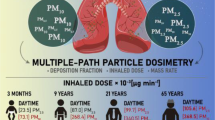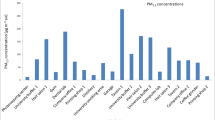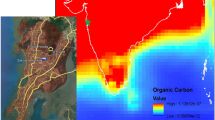Abstract
This study aimed to calculate size-fractionated PM-bound metals concentration (Co, V, Ni, Cu, Mn, As, Cd, Pb, Cr and Hg) in a European hot spot area in terms of PM air pollution (Zabrze, Poland) and to show their deposition ratios in human airways. Additionally, meteorological data was used to conclude the probable influence of atmospheric conditions on the variability of the PM mass concentrations in different periods of the year. Data regarding the elemental composition of size-fractionated PM in various regions of Poland was also presented. The determination of the selected metals in PM-fractionated samples (PM1, PM2.5, and PM10) was performed in two periods – the heating and non-heating season. It was found that metals were primarily associated with particles less than 1 µm, however, the PM size distribution had shown bi-modal characteristics and the maxima of metal mass distribution occurred in both submicron and fine modes. High PM1 mass loadings, observed especially in the non-heating season were probably due to an influx of fine and even smaller particles from traffic sources. Metals distributions as well as respiratory deposition ratios for PM-bound elements calculated using the MPPD V2.11 model favored nasal and head deposition. The overall mass deposition of metals in the respiratory tract of adults was: 0.39 (Head region, H); 0.07 (Tracheobronchial region, TB); 0.16 (Pulmonary region, P) respectively. No matter the season, the highest inhalable concentrations of metals were found for Cu, Mn, Cr and Pb. Only Cr and Pb are classified as carcinogenic and mutagenic (according to IARC classification).






Similar content being viewed by others
Data availability
The datasets generated during and/or analyzed during the current study are available from the corresponding author on reasonable request.
References
Akhtar, U.S., et al.: The combined effects of physicochemical properties of size-fractionated ambient particulate matter on in vitro toxicity in human A549 lung epithelial cells. Toxicol. Rep. 1, 145–156 (2014)
Antonini, J.M., et al.: Persistence of deposited metals in the lungs after stainless steel and mild steel welding fume inhalation in rats. Arch. Toxicol. 85(5), 487–498 (2011)
Błaszczak, B., et al.: The Role of PM2.5 Chemical Composition and Meteorology during High Pollution Periods at a Suburban Background Station in Southern Poland. Aerosol Air Qual. Res. 20(11), 2433–2447 (2020)
Brunekreef, B., et al.: Effects of long-term exposure to traffic-related air pollution on respiratory and cardiovascular mortality in The Netherlands: The NLCS-AIR study. Research report (Health Effects Institute) 139, 5–71 discussion 73 (2009)
Chalvatzaki, E., et al.: Assessment of the Personal Dose Received by School Children due to PM10 Air Pollution in Lisbon. Aerosol and Air Quality Research 20(6), 1384–1397 (2020)
Chen, L.C., Lippmann, M.: Effects of Metals within Ambient Air Particulate Matter (PM) on Human Health. Inhalation Toxicol. 21(1), 1–31 (2009)
Costa, D., Dreher, K.L.: Bioavailable transition metals in particulate matter mediate cardiopulmonary injury in healthy and compromised animal models. Environ. Health Perspect. 105, 1053–1060 (1997)
Darquenne, C.: Aerosol Deposition in Health and Disease. J. Aerosol Med. Pulm. Drug Deliv. 25(3), 140–147 (2012)
Duplissy, J., et al.: Relating hygroscopicity and composition of organic aerosol particulate matter. Atmos. Chem. Phys. 11(3), 1155–1165 (2011)
Galindo, N., et al.: The Influence of Meteorology on Particulate Matter Concentrations at an Urban Mediterranean Location. Water Air Soil Pollut. 215(1–4), 365–372 (2011)
Gao, P., Guo, H., Zhang, Z., Ou, C., Hang, J., Fan, Q., He, C., Wu, B., Feng, Y., Xing, B.: Bioaccessibility and exposure assessment of trace metals from urban airborne particulate matter (PM10 and PM2.5) in simulated digestive fluid. Environ. Pollut. 242(Pt B), 1669–1677 (2018). https://doi.org/10.1016/j.envpol.2018.07.109. Epub 2018 Jul 26. PMID: 30077404
Geiger, A., Cooper, J.: Overview of airborne metals regulations, exposure limits, health effects, and contemporary research, pp. 1–56. Environmental Protection Agency, Portland (2010)
Gunawardena, J., et al.: Role of traffic in atmospheric accumulation of heavy metals and polycyclic aromatic hydrocarbons. Atmos. Environ. 54, 502–510 (2012)
Halatek, T., et al.: “The inflammatory response in lungs of rats exposed on the airborne particles collected during different seasons in four European cities.” Journal of environmental science and health. Part a, Toxic/hazardous Substances & Environmental Engineering 46, 1469–1481 (2011)
Han, X.Y., et al.: Concentrations, Source Characteristics, and Health Risk Assessment of Toxic Heavy Metals in PM2.5 in a Plateau City (Kunming) in Southwest China. Int. J. Environ. Res. Pub. Health. 18(21) (2021)
Happo, M., et al.: Inflammation and tissue damage in mouse lung by single and repeated dosing of urban air coarse and fine particles collected from six European cities. Inhalation Toxicol. 22, 402–416 (2010)
Hoek, G., et al.: Long-term air pollution exposure and cardio-respiratory mortality: a review. Environ Health 12 (2013)
Huang, X., et al.: Bioaccessibility of Airborne Particulate-Bound Trace Elements in Shanghai and Health Risk Assessment. Front. Environ. Sci. 4(76), (2016)
Juda-Rezler, K., Toczko, B.: Ed. Pyły drobne w atmosferze. Kompendium wiedzy o zanieczyszczeniu powietrza pyłem zawieszonym w Polsce. Inspekcja Ochrony Środowiska, Warszawa. (2016)
Kelly, F.J., Fussell, J.C.: Air pollution and public health: emerging hazards and improved understanding of risk. Environ. Geochem. Health 37(4), 631–649 (2015)
Klejnowski, K., et al.: Number Size Distribution of Ambient Particles in a Typical Urban Site: The First Polish Assessment Based on Long-Term (9 Months) Measurements. Sci. World J. 2013, 539568 (2013)
Klejnowski, K., Pastuszka, J.S., Rogula-Kozłowska, W., Talik, E., Krasa, A.: Mass size distribution and chemical composition of the surface layer of summer and winter airborne particles in Zabrze. Poland. Bull Environ Contam Toxicol. 88(2), 255–259 (2011)
Krzemińska-Flowers, M., Bem, H., Górecka, H.: Trace Metals Concentration in Size-Fractioned Urban Air Particulate Matter in Łódź, Poland. I. Seasonal and Site Fluctuations. Polish J. of Environ. Stud. 15, 759–767 (2006)
Kuskowska, K., Rogula-Kozłowska, W., Widziewicz, K.: A preliminary study of the concentrations and mass size distributions of particulate matter in indoor sports facilities before and during athlete training. Environ. Prot. Eng. 45, 103-112 (2019)
Kwon, H.O., et al.: Size distributions of atmospheric particulate matter and associated trace metals in the multi-industrial city of Ulsan. Korea. Environ. Eng. Res. 24(2), 331–338 (2019)
Leikauf, G.D., Kim, S.H., Jang, A.S.: Mechanisms of ultrafine particle-induced respiratory health effects. Exp. Mol. Med. 52, 329–337 (2020). https://doi.org/10.1038/s12276-020-0394-0
Luo, X.S., et al.: Spatial-temporal variations, sources, and transport of airborne inhalable metals (PM10) in urban and rural areas of northern China. Atmos. Chem. Phys. Discuss. 2014, 13133–13165 (2014)
Manojikumar, N., Srimuruganandam, B., Nagendra, S.M.S.: Application of multiple-path particle dosimetry model for quantifying age specified deposition of particulate matter in the human airway. Ecotox. Environ. Safe. 168, 241–248 (2019)
Martin, R., et al.: Trace metal content in inhalable particulate matter (PM2.5-10 and PM2.5) collected from historical mine waste deposits using a laboratory-based approach. Environ. Geochem. Health 39(3), 549–563 (2017)
Mukhtar, A., Limbeck, A.: Recent developments in the assessment of bio-accessible trace metal fractions in the airborne particulate matter: A review. Anal. Chim. Acta 774, 11–25 (2013)
Pastuszka, J.S., Rogula-Kozłowska, W., Zajusz-Zubek, E.: Characterization of PM10 and PM2.5 and associated heavy metals at the crossroads and urban background site in Zabrze, Upper Silesia, Poland, during the smog episodes. Environ. Monit. Assess. 168, 613–627 (2010)
PN-EN 12341:2014–07 Ambient air – Standard gravimetric measurement method to determine the concentration of mass fractions PM10 or PM2.5 particulate matter
Pope, C.A., Dockery, D.W.: Health effects of fine particulate air pollution: lines that connect. J. Air Waste Manag. Assoc. 56, 709–742 (2006)
Pyta, H., Rogula-Kozłowska, W.: Determination of mercury in sizesegregated ambient particulate matter using CVAAS. Microchem. J. 124, 76–81 (2016)
Report of the Chief Inspectorate of Environmental Protection: Analysis of the state of air pollution with PM10 and PM2.5 particulate matter, taking into account PM chemical composition and the impact of natural sources – final report [Raport Głównego Inspektoratu Ochrony Środowiska: Analiza stanu zanieczyszczenia powietrza pyłem PM10 i PM2,5 z uwzględnieniem składu chemicznego pyłu oraz wpływu źródeł naturalnych – raport końcowy]. Zabrze, April 2011
Rogula-Kozłowska, W., et al.: Effects of road traffic on the ambient concentrations of three PM fractions and their main components in a large Upper Silesian city. Annals of Warsaw University of Life Sciences – SGGW Land Reclamation 45(2), 243–253 (2013)
RIVM 2002 National Institute for Public Health and the Environment (RIVM). Multiple Path Particle Dosimetry Model (MPPD v 1.0): A Model for Human and Rat Airway Particle Dosimetry. Bilthoven, The Netherlands. RIVA Report 650010030. (2002)
Rogula-Kozłowska, W.: Traffic-generated changes in the chemical characteristics of size-segregated urban aerosols. Bull Environ Contam Toxicol 93, 493–502 (2014). https://doi.org/10.1007/s00128-014-1364-9
Rogula-Kozłowska, W.: Size-segregated urban particulate matter: mass closure, chemical composition, and primary and secondary matter content. Air Qual. Atmos. Health. 9, 533–550 (2016)
Rogula-Kozłowska, W., et al.: Hazardous compounds in urban PM in the central part of Upper Silesia (Poland) in winter. Arch. Environ. Prot. 39, 53–65 (2013a)
Rogula-Kozlowska, W., et al.: Concentration and elemental composition of atmospheric fine particles in Silesia province, Poland. [In] Environ. Eng. III, Pawłowski, Dudzińska. & Pawłowski (eds.), Taylor & Francis Group, London. 75–81 (2010)
Rogula-Kozłowska, W., Klejnowski, K., Rogula-Kopiec, P., Błaszczak, B., Mathews, B., Szopa, S.: Masowy rozkład pierwiastków w próbkach pyłu zawieszonego pobranych w obszarze tła miejskiego: wyniki ośmiomiesięcznych badań w Zabrzu, Rocznik Ochrona. Środowiska. 15(2), (2013b)
Rogula-Kozłowska, W., Klejnowski, K.: Submicrometer aerosol in rural and urban backgrounds in Southern Poland: primary and secondary components of PM1. Bull. Environ. Contam. Toxicol. 90, 103–109 (2013)
Rogula-Kozłowska, W., Mach, T., Rogula-Kopiec, P., Rybak, J., Nocoń, K.: Concentration and elemental composition of quasi-ultrafine particles in Upper Silesia. 45(1), 171-184 (2019)
Rogula-Kozłowska, W., Majewski, G., Czechowski, O.: The size distribution and origin of elements bound to ambient particles: a case study of a Polish urban area. Environ. Monit. Assess. 187, 240 (2015)
Schwarze, P.E., et al.: Particulate matter properties and health effects: consistency of epidemiological and toxicological studies. Hum. Exp. Toxicol. 25(10), 559–579 (2006)
Sówka, I., et al.: Seasonal variations of PM2.5 and PM10 concentrations and inhaled exposure from pm-bound metals (As, Cd, Ni): first studies in Poznań. Archives of Environmental Protection 44, 86–95 (2018)
Valavanidis, A., et al.: Pulmonary Oxidative Stress, Inflammation, and Cancer: Respirable Particulate Matter, Fibrous Dusts and Ozone as Major Causes of Lung Carcinogenesis through Reactive Oxygen Species Mechanisms. Int. J. Environ. Res. Public Health 10(9), 3886–3907 (2013)
Waheed, A., et al.: Size Distribution and Sources of Trace Metals in Ultrafine/Fine/Coarse Airborne Particles in the Atmosphere of Shanghai. Aerosol Sci. Technol. 45(2), 163–171 (2011)
Weggeberg, H., et al.: Characterization and bioaccessibility assessment of elements in urban aerosols by extraction with simulated lung fluids. Environmental Chemistry and Ecotoxicology 1, 49–60 (2019)
WHO.: Air quality guidelines for Europe, second edition. (WHO regional publications. European series. No. 9). (2000)
Widziewicz, K., Loska, K.: Metal induced inhalation exposure in an urban population: A probabilistic approach. Atmos. Environ. 128, 198–207 (2016)
Widziewicz, K., Rogula-Kozłowska, W.: Urban environment as a factor modulating metals deposition in the respiratory tract and associated cancer risk. Atmos. Pollut. Res. 9(3), 399–410 (2018)
Widziewicz, K., Rogula-Kozlowska, W., Loska, K., Kociszewska, K., Majewski, G.: Health Risk Impacts of Exposure to Airborne Metals and Benzo(a)Pyrene during Episodes of High PM10 Concentrations in Poland. Biomed Environ Sci. 31(1), 23–36 (2018). https://doi.org/10.3967/bes2018.003. (PMID: 29409582)
Widziewicz-Rzonca, K., et al.: Strongly and Loosely Bound Water in Ambient Particulate Matter-Qualitative and Quantitative Determination by Karl Fischer Coulometric Method. Sustainability 12(15), (2020)
Wiseman, C., Zereini, F.: Characterizing metal(loid) solubility in airborne PM10, PM2.5, and PM1 in Frankfurt, Germany using simulated lung fluids. Atmos. Environ. 89, 282–289 (2014)
Ye, H.J., et al.: Hourly Variations and Potential Sources of Airborne Trace Elements in PM10 in Four Representative Regions of Southeastern China. Aerosol and Air Quality Research 14(7), 1986–1997 (2014)
Zhang, K., et al.: Size distribution and source of heavy metals in the particulate matter on the lead and zinc smelting affected area. J Environ. Sci. 71, 188–196 (2018)
Zwoździak, A., Gini, M.I., Samek, L., Rogula-Kozlowska, W., Sowka, I., Eleftheriadis, K.: Implications of the aerosol size distribution modal structure of trace and major elements on human exposure, inhaled dose, and relevance to the PM2.5 and PM10 metrics in a European pollution hotspot urban area. J. Aerosol Sci. 103, 38–52 (2017)
Zwoździak, A., Sówka, I., Krupińska, B., Zwoździak, J., Nych, A.: Infiltration or indoor sources as determinants of the elemental composition of particulate matter inside a school in Wrocław, Poland? Build. Environ. 66, 173–180 (2013)
Further reading
Rogula-Kozłowska, W., Klejnowski, K., Rogula-Kopiec, P., et al.: A Study on the Seasonal Mass Closure of Ambient Fine and Coarse Dusts in Zabrze. Poland. Bull Environ. Contam. Toxicol. 88, 722–729 (2012)
Rogula-Kozłowska, W., Majewski, G., Czechowski, P.O.: Rogula-Kopiec, P Analysis of the data set from a two-year observation of the ambient water-soluble ions bound to four particulate matter fractions in an urban background site in Southern Poland. Environ. Prot. Eng. 43(1), 137–149 (2017)
Rogula-Kozłowska, W., Rogula-Kopiec, P., Mathews, B., Klejnowski, K.: Effects of road traffic on the ambient concentrations of three PM fractions and their main components in a large Upper Silesian city. Ann Warsaw Univ Life Sci - SGGW Land Reclam. 45, 243–253 (2013d)
Rogula-Kozłowska, W., Rogula-Kopiec, P., Klejnowski, K., Błaszczyk, J.: Wpływ emisji komunikacyjnej na stężenie dwóch form węgla i rozkład ich masy względem wielkości cząstek w aerozolu atmosferycznym obszaru miejskiego. Annual Set the Environment Protection. 15, 1623–1644 (2013c)
Rogula-Kozłowska, W., Sówka, I., Mathews, B., Klejnowski, K., Zwoździak, A., Kwiecińska, K.: Size-Resolved Water-Soluble Ionic Composition of Ambient Particles in an Urban Area in Southern Poland. J. Environ. Prot. 4, 371–379 (2013e)
Samek, L., et al.: Chemical composition of submicron and fine particulate matter collected in Krakow, Poland. Consequences for the APARIC project. Chemosphere 187, 430–439 (2017)
Slezakova, K., et al.: Trace metals in size-fractionated particulate matter in a Portuguese hospital: exposure risks assessment and comparisons with other countries. Environ. Sci. Pollut. Res. 21(5), 3604–3620 (2014)
Sówka, I., Chlebowska-Styś, A., Pachurka, Ł., Rogula-Kozłowska, W., Mathews, B.: Analysis of Particulate Matter Concentration Variability and Origin in Selected Urban Areas in Poland. Sustainability 11, 5735 (2019)
Wawroś, A., Talik, E., Żelechower, M., Pastuszka, J.S., Skrzypek, D., Ujma, Z.: Seasonal Variation in the Chemical Composition and Morphology of Aerosol Particles in the Centre of Katowice. Poland. Polish Journal of Environmental Studies 12(5), 619–627 (2003)
Acknowledgements
This work was financed under the subsidy for basic statutory activity no. 1a – 119/2020 “Temporal and spatial variability of the chemical composition of atmospheric aerosols as a tool for assessing the effects of implementing air protection programs in Poland”.
Author information
Authors and Affiliations
Contributions
All authors contributed to the study design. Material preparation, the concept of the manuscript, full description, and analysis were performed by [Kamila Widziewicz-Rzońca], data collection was performed by [Halina Pyta and Krzysztof Słaby], samples preparation, gravimetric analyses, and data management was coordinated by [Barbara Mathews together with Monika Błaszczak and Patrycja-Rogula-Kopiec]. The first draft of the manuscript was written by [Kamila Widziewicz-Rzońca] and consulted with [Barbara Błaszczak]. Funding acquisition was supervised by [Krzysztof Klejnowski]. All authors commented on previous versions of the manuscript. All authors read and approved the final manuscript.
Corresponding author
Ethics declarations
Competing interests
The authors declare that they have no known competing financial interests or personal relationships that could have appeared to influence the work reported in this paper.
Additional information
Publisher's Note
Springer Nature remains neutral with regard to jurisdictional claims in published maps and institutional affiliations.
Rights and permissions
About this article
Cite this article
Widziewicz-Rzońca, K., Pyta, H., Słaby, K. et al. Analysis of the seasonal and fractional variability of metals bearing particles in an urban environment and their inhalability. J Atmos Chem 80, 77–101 (2023). https://doi.org/10.1007/s10874-022-09438-z
Received:
Accepted:
Published:
Issue Date:
DOI: https://doi.org/10.1007/s10874-022-09438-z




